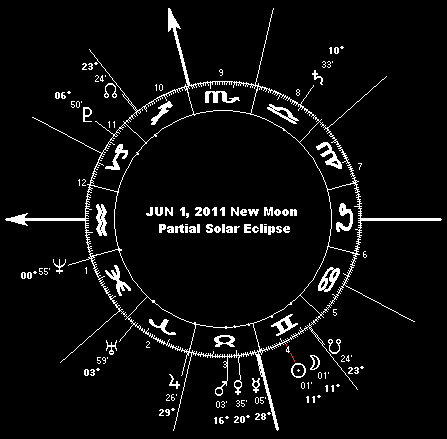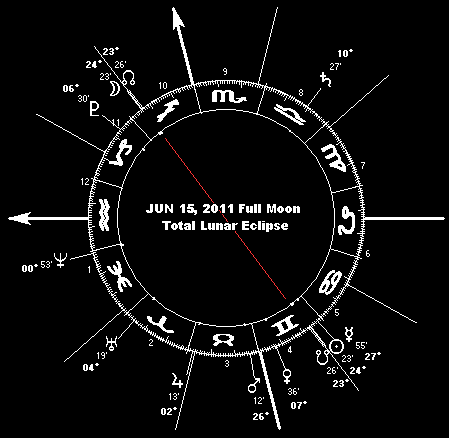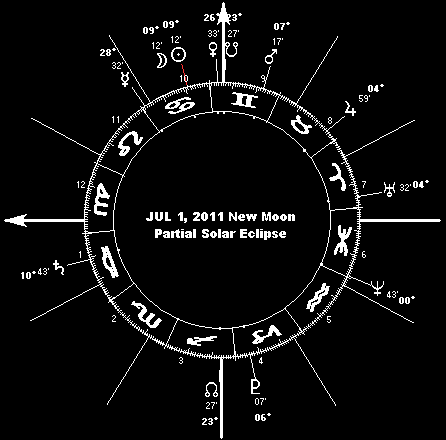If you were expecting some kind of sun sign nonsense, forget about it. This is real astrology for the real world, not some mystical mumbo-jumbo word salad. If it's real astrology for yourself that you want, you can get it by phone or in print. And if you need help deciphering the astrological glyphs in the graphics accompanying this article, see Astroglyphs: Astrological Symbols Guide. Please note: this forecast is expressed in terms of Universal Time (UT). Also please be aware that, while I never change a forecast once it's published, I do post errata to acknowledge typographical errors and the like.
The past and future are veiled; but the past wears the widow's veil; the future, the virgin's.
-- Jean Paul Richter
 The geocosmic shock window for the June 1 partial solar eclipse at 11° 01 Gemini has been in effect since May 24, and continues through June 10 (extended by the southward equatorial crossing on June 9). In case you missed last months errata , please note that theres a typographical error (transposition of digits) in my May forecast description of the June 1, 2011 partial solar eclipse as occurring at "1° 11 Gemini". That should read "11° 01 Gemini", as correctly stated above. This same typo appears in the 2011 World Forecast Highlights (top of second paragraph, page 24 in the print edition), in the sections addressing this eclipse.
The geocosmic shock window for the June 1 partial solar eclipse at 11° 01 Gemini has been in effect since May 24, and continues through June 10 (extended by the southward equatorial crossing on June 9). In case you missed last months errata , please note that theres a typographical error (transposition of digits) in my May forecast description of the June 1, 2011 partial solar eclipse as occurring at "1° 11 Gemini". That should read "11° 01 Gemini", as correctly stated above. This same typo appears in the 2011 World Forecast Highlights (top of second paragraph, page 24 in the print edition), in the sections addressing this eclipse.
The first in a series of three consecutive eclipses two in June and one in July - this one belongs to Saros Cycle 118, which began on May 24 in the year 803 a time of great migration (due at least in part to changing climate) and the conflict it engendered. (Think Vikings and Moors in Europe. Now look around you.) A couple of things are notable about this eclipse. One is that it makes no major aspects to anything else in the sky. Usually that means that its a big newsmaker in its own right in terms of geophysical effects like storms and seismicity, in other words. The other is that something else is very much in focus in the skies as the eclipse lines up: a Saturn-Uranus opposition, and a Venus-Mars conjunction. These two planetary alignments suggest that a familiar theme hits the headlines again around this time, as I've been describing for some time already: "panic in the markets, panic in the streets, people in need of rescue, just a whiff of revolution in the air" in the case of Saturn-Uranus, and lust and avarice in the case of Venus-Mars. These are signs that this is good time to be on the sidelines, rather than in the thick of the fray whether its the markets or the streets. Not a good time to be in line at your bank.
Theres already been a lot of that panic and revolution stuff in the news all year, intensifying since the June 1 eclipse window opened on May 24 from protests in Greece to outright revolution in Libya, Syria, Egypt, etc.; to shockwaves in major equity markets just about planet-wide. As for examples of the lust and avarice end of things, the sexual assault cases of former IMF head Dominique Strauss-Kahn and former Egyptian Bank head Mahmoud Abdel-Salam Omar both hit the news while Venus and Mars were within a few degrees of their exact alignment on May 23. (From these two examples, it only gets worse.)
Visible mainly in the Arctic, across Alaska, northern Canada, Greenland and Iceland, the June 1 eclipse happens within a half-day of the Moons northern declination peak. The geocosmic shock window for this particular alignment runs from May 24 through June 10 (extended by the southward equatorial crossing on the 9th). The most intense action during the June portion of this period is likely around the 1st and 2nd, as well as the 9th. Powerful storms with damaging winds and heavy precipitation as well as moderate-to-severe seismic activity (including volcanic eruptions) associated with this eclipse will likely focus on the area of visibility mentioned above. But they will not be limited to this zone, due to the planet-wide scale of the geocosmic shock window associated with each and every eclipse. Astro-locality analysis shows a number of possible target zones. Theres a longitudinal meridian running from the Pacific Ocean across Alaska and over the pole down through Russia, the Middle East and East Africa; also a horizon arc sweeping across Great Britain and northern Europe, down through China, the Philippines, New Guinea and Indonesia, on across Australia (and just off the New Zealand coast), to emerge in South America (arcing over Chile, Argentina, Paraguay and Brazil and out across the Atlantic).
 Neptune spends the whole month within a fraction of a degree of its June 3 retrograde station; likewise Saturn with respect to its June 13 direct station and Uranus with its July 10 retrograde station. Saturn continues from last month its involvement in a loose, sliding T-Square configuration with Uranus and Pluto, so theres lots more "whiff of revolution in the air" and financial crisis stuff breaking out here and there this month: debt panic, shortfalls, niggardly austerity. I dont expect a major crash by any means: the Venus Max, as I have already indicated, should carry us through until August. But that does make a pull-back and buying opportunity look pretty likely this month or next. If there are good, solid companies youve been looking to buy, have some cash on hand in case theres a chance to get those shares at a discount in June or July. Precious metals particularly gold and silver wont continue on a parabolic upwards arc forever, but for now theyre also worth a buy on a pull-back.
Neptune spends the whole month within a fraction of a degree of its June 3 retrograde station; likewise Saturn with respect to its June 13 direct station and Uranus with its July 10 retrograde station. Saturn continues from last month its involvement in a loose, sliding T-Square configuration with Uranus and Pluto, so theres lots more "whiff of revolution in the air" and financial crisis stuff breaking out here and there this month: debt panic, shortfalls, niggardly austerity. I dont expect a major crash by any means: the Venus Max, as I have already indicated, should carry us through until August. But that does make a pull-back and buying opportunity look pretty likely this month or next. If there are good, solid companies youve been looking to buy, have some cash on hand in case theres a chance to get those shares at a discount in June or July. Precious metals particularly gold and silver wont continue on a parabolic upwards arc forever, but for now theyre also worth a buy on a pull-back.
Between the solar eclipse at the beginning of June and the one on July 1st, and the lunar eclipse at mid-month, the better part of June unfolds under the aegis of notable geocosmic stress signals. The first of two total lunar eclipses this year debuts on June 15, at 24° 23 Sagittarius. Mercury and the Sun are conjunct for this eclipse, while the Moon crosses through the degree of Pluto the next day. Saturn and Uranus are still in their loose opposition alignment, so theres bound to be some market turbulence and unsettling economic developments afoot during this eclipse window and still a fair amount of social unrest due to tough economic times. (The rich get richer, and wonder why the poor dont eat cake.) Breaking news and issues centered on communication, transportation and other infrastructure stir the pot this time around. I make this particular eclipse window to be June 11-18, kicking in a little early in advance of the lunar perigee on the 12th. The June 15 eclipse belongs to Saros Cycle 130, which began on June 10, 1416 the year that the Chinese fleet commanded by Zheng He reached Aden, and after looking around decided that the Middle East (and Europe, for that matter) was so backward as to be of no interest to China. If thats not an omen for our times, I dont know what is. If theres a difference today, its that China needs resources and markets.
Of course the storm and seismic upsurge associated with this eclipse will be worldwide. However it may be more intense in the regions where the entire eclipse will be visible from beginning to end: east Africa, the Middle East, central Asia and western Australia. Other zones of vulnerability appear to track the longitudinal zone on the exact opposite side of the world: from western North America on out into the Pacific Ocean. Also suspicious looking is a horizon arc that stretches from the northwest coast of Africa across western and northern Europe and Russia, coming down through eastern China, the Korean Peninsula and Japan, out into the Pacific Ocean to cross Papua New Guinea and New Zealand. These are the likeliest zones for severe storms with damaging winds and heavy precipitation (and subsequent flooding), extreme tidal surges, and moderate-to-severe seismic activity (magnitude 5+ earthquakes, tsunami and volcanic eruptions) in the June 11-18 time frame especially on or about the 12th and 15th.
 The July 1 partial solar eclipse at 9° 12 Cancer falls in the middle of the Antarctic Ocean, and so will be seen only by more or less fanatical eclipse-chasers. Its the first in the Saros 156 series, which runs to the year 3237. Making a Grand Cross in the heavens, the eclipse opposes Pluto, and is squared by the Saturn-Uranus opposition. Being a solar eclipse, it has a shock window that runs from June 25 to July 8, with critical peaks around June 29 (the Moon reaching maximum declination north of the celestial equator), as well as July 1 and 6 (the day the Moon crosses the celestial equator headed south). In terms of mass psychology, this is a time when the fear of loss is amplified. Another debt crisis is likely under the aegis of the July 1 eclipse, and thats a fairly solid indicator of a certain level of panic in the equity markets. People look for safe harbors at times like this, financially speaking: toward precious metals, away from vulnerable currencies.
The July 1 partial solar eclipse at 9° 12 Cancer falls in the middle of the Antarctic Ocean, and so will be seen only by more or less fanatical eclipse-chasers. Its the first in the Saros 156 series, which runs to the year 3237. Making a Grand Cross in the heavens, the eclipse opposes Pluto, and is squared by the Saturn-Uranus opposition. Being a solar eclipse, it has a shock window that runs from June 25 to July 8, with critical peaks around June 29 (the Moon reaching maximum declination north of the celestial equator), as well as July 1 and 6 (the day the Moon crosses the celestial equator headed south). In terms of mass psychology, this is a time when the fear of loss is amplified. Another debt crisis is likely under the aegis of the July 1 eclipse, and thats a fairly solid indicator of a certain level of panic in the equity markets. People look for safe harbors at times like this, financially speaking: toward precious metals, away from vulnerable currencies.
As for its storm and seismic potential, expect the usual during the June 25-July 8 geocosmic shock window: powerful storms with damaging winds and heavy precipitation, moderate-to-severe seismic activity (magnitude 5 and up earthquakes, plus the occasional tsunami and an up-tick in volcanic eruptions), and high tidal surges. Where? Nowhere is beyond the reach of these stirrings in Earths crust, seas and atmosphere. But astro-locality mapping suggests that western Russia, the Middle East and east Africa are among the riskier zones, along with a longitudinal arc from Alaska due south through the Pacific Ocean. Theres also a suspicious-looking horizon arc sweeping across western Australia, New Guinea and Indonesia, through the Pacific to traverse Kamchatka, the Bering Strait and Alaska, crossing from there through northern Canada and the US Northeast, crossing the Atlantic southeasterly to touch eastern Brazil.
Last but not least, keep your eyes open and your wits about you in the days surrounding a week before and after the June 24 opposition from the Red Planet to the degree of the November 25, 2011 solar eclipse. This is one of those "if it bleeds, it leads" periods, roughly a fortnight (from around June 17 through July 1) when martial behavior and all the rest of the Red Planet stuff belligerence, clashes personal and social (from assault to murder to riots in the street), military and paramilitary attacks (including terrorism), fires, crashes and explosions will emerge from their normal background levels into headline prominence. The most recent high Mars episode like this occurred within days either way of last months (May 1) Mars-Jupiter conjunction. If that date sounds familiar, think Abbotobad, Pakistan; and remember that all major Mars factors indicate, as described in my 2011 World Forecast Highlights, a "period of elevated tension and conflict, the kind of atmosphere that cultivates inflamed passions, hot tempers and rash, even violent action - of the criminal and military type, from terrorist atrocities to large scale military conflict."
 SPECIAL FEATURE: This month's birthdays of the famous and infamous (with astrological birth charts)
SPECIAL FEATURE: This month's birthdays of the famous and infamous (with astrological birth charts)